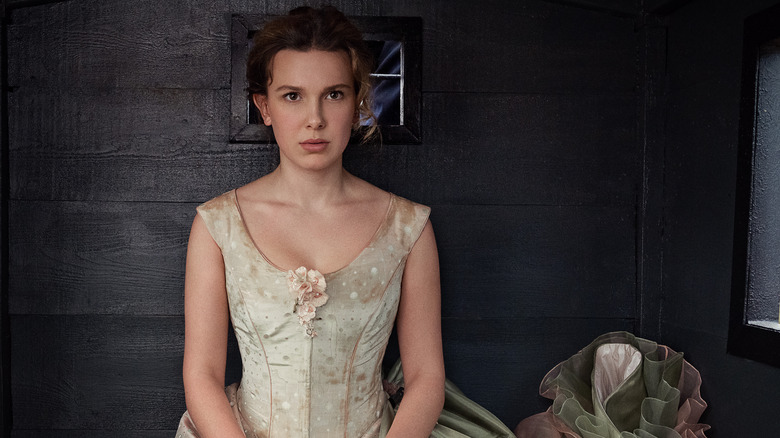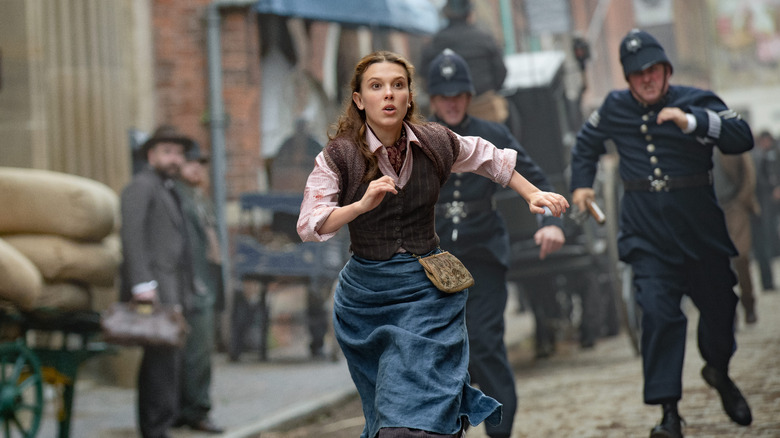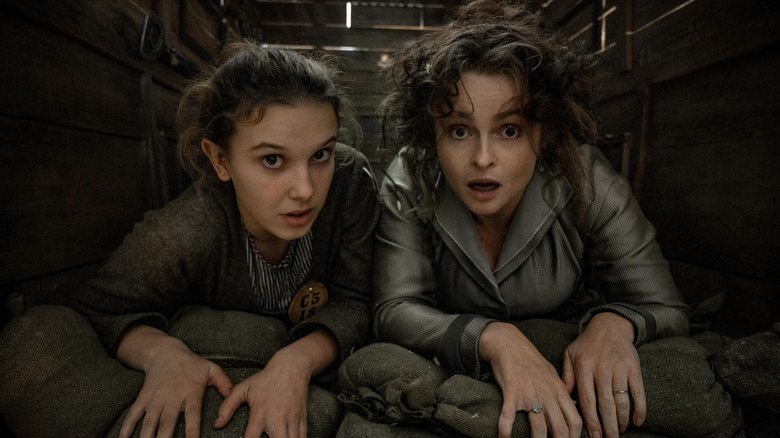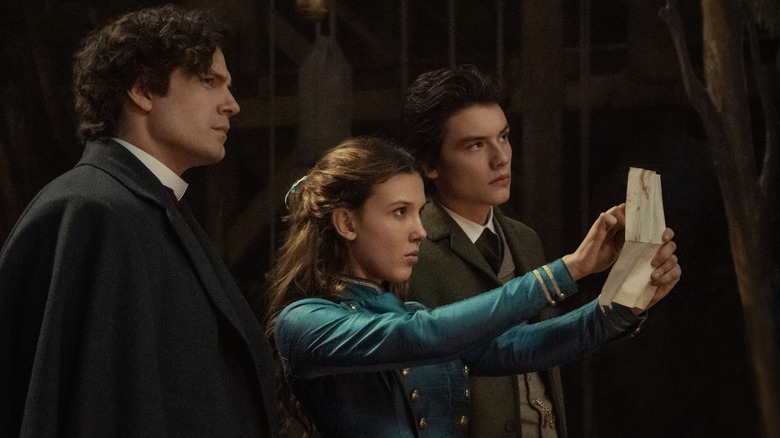Enola Holmes 2 Director Harry Bradbeer On A More Mature Enola And Throwing Soup Cans From Carriages [Exclusive Interview]
"Enola Holmes 2," based on Nancy Springer's young adult novel series, premieres next week on Netflix, and sees the return of Enola (Millie Bobby Brown), who is a little older now, more mature, and ready to start her own detective agency. Of course, that was no easy task for a woman in the time period when this film takes place. Enola takes on the case of a missing girl who has been working at a matchstick factory, where the conditions are terrible, and she quickly discovers there is a lot more going on than meets the eye.
In fact, the story is based on the Matchgirls' Strike of 1888. The working conditions in the Bryant & May factory were devastatingly bad, with low pay and dangerous conditions leading to illness and death.
Joining her in her quest to solve this mystery are her brother, the famous Sherlock Holmes (Henry Cavill); her mother, Eudoria (Helena Bonham Carter); Edith (Susie Wokoma); and Tewkesbury (Louis Partridge); just to name a few.
I recently spoke to director Harry Bradbeer ("Fleabag," "Killing Eve") about the film's message, a wild carriage chase, and the real story of the Matchgirls' strike and how it influenced the movie.
'It was the first strike by women for women'
There's this strong message here that I love about being independent, but also being willing to ask for help and being stronger together. I'd love to hear your thoughts on why that was important to portray.
Well, the first film was about [Enola] on her own, and it felt like a way to take her on, to make her grow up as Millie herself was growing up. And I think [writer] Jack [Thorne] put it beautifully as saying it's a story from "I" to "we."
The hardest thing, sometimes, is to accept help. And also, when pride gets in the way, that's even tougher. Pride is sort of her Achilles heel, like a lot of our lot great and interesting characters. She wants to do it on her own. And we love the idea of cooperation because it helped to build a story with Sherlock. Everybody wanted her to work with Sherlock and to solve case together. It brought her together with Louie [who plays Viscount Tewkesbury] in an active way and have him take part in it.
But in particular, it allowed us to tell a story, which we had been looking into, which was the Matchgirls' Strike of 1888, a real historical event that allowed us to put Enola in a totally different world, not of aristocrats and fancy country houses, but of grim industrial work and a whole sisterhood of girls from a very different background.
So that's how it came about, really, and with some kind of exciting, fulfilling ending. It took a long time to plot, though, I have to say.
I love that this is based on that real story. With everything going on in the UK and around the world with strikes right now, was that part of the reason you picked this specific one?
Well, it was the first strike by women for women. So a big formative moment in that movement and about unions. And it coincided with the 1880s, which was our period. I'd read that story when I was a history student. I was always shocked by the fact that there were these — and were photographs of them — that these girls worked despite what was happening to them. And they had these terrible malformaties and pain, struggle, and sometimes death. So it seemed to be a darker kind of mystery with more of a disturbing potential outcome and dealing with — which is, again, true to the fact — corrupt and greedy bosses weighing down on the workers. So there seems to be a very clear case of right and wrong here, but wrapped up in quite a twisty corruption blackmail world, which could be something that both she and Sherlock could interact with here.
'In the middle of a carriage with your mother throwing bombs'
You have a carriage chase in here, which is so much fun. Can you tell us a little bit about shooting that?
Oh my God. Well, first of all, we were going to do it in the city. She was broken out of a city jail, but it involved basically the carriage running through the same three streets for about 20 minutes, which I think we'd have gotten tired of. So we moved it into the country. And then it kind of got bigger and smaller and bigger and smaller, and I kept on pushing for more and more second unit days. It was a big old affair.
The idea of unpacking a plot whilst you're in the middle of a carriage with your mother throwing bombs out and telling the story, I think that was the point when I realized I had the key to it. Because we've seen carriage chases obviously a million times in "Ben Hur" and other films. But we knew we couldn't compete ... with these amazing, long lovely carriage chases. But we had to do it our own way, which involved this mad, eccentric center of this conversation between mother and child whilst kind of catching up.
And I always loved the idea of the mother talking while she starts to prepare the soup can, and you're going, "What? Where is this going?" So the opportunity for putting a lot of humor into something that was properly dangerous — that seemed irresistible. It took a lot of effort on a lot of people's parts, but fun.
I love the idea of anachronistic storytelling. But really, it's not that anachronistic, it's just that they didn't write women's stories down. So I'd love to hear you talk a little bit about that.
Oh, well, that's true, of course. And there are a lot of forgotten histories amongst various minorities of all kinds. Those women's stories were there to be telling. I mean, people didn't know, for instance, that the suffrage movement, which everyone thinks of as being something in the early 20th century, did begin in the mid-19th century. And that was not anachronistic.
There was a prominent suffragette, Emmeline Pankhurst, who was operating in that earlier period. I think I'm right in saying that, certainly one of the Pankhursts. And so yeah, we dug into that feminist history, and we found things that we weren't that aware of. And the Matchgirls' Strike is a real thing, as we say. So based on fact. Is it possible or probable? No, it's probably fairly improbable that you would have someone in a carriage throwing soup cans out. However, it's perfectly possible. And when you take that view, and you put in some research, then you come into something that we can all accept and run with.
'There's lots of talk' [about a sequel]
One of the things that's so cool in here is that you got a kiss that happens, but it is started by the woman. And I'm curious that there are so many little touches like that. How important was that for you to get in there?
Well, it had to be done like that, I think. That kiss, yeah, that was written fully formed by Jack. I had the idea that she would teach him to fight, and then eventually, they would end up kissing. Yeah. I mean, it had to be her kissing him, really, didn't it? And also, if you would watch [laughs] — and this is Adam [Bosman], my brilliant editor, his idea — he closes his eyes during the kiss and he pulls back in the time-honored fashion of all kissed girls on every prom night, with his eyes still closed. He's, like, swooning. So we couldn't resist that either.
It's so cute. I totally noticed that. You have some really good teases at the end of this and some amazing casting. So, are there any plans for another one? Because I want one.
Well, I'm really glad you do. There's lots of talk. There is lots of talk and thoughts, and there's a lot of things we can do. So we kind of got an embarrassment of riches. We're thinking about it.
Is there also a possibility — I can't believe I'm asking about a prequel, but I want a prequel about her mother. Prequels are good lately. I don't know why. But is that something you're exploring, in case you can't get Henry?
Well, it's a very smart thing for you to say. It has come up. It has come up. Through the mother's story. Yeah, it has come up.
Are there any specific influences that really grabbed you in terms of the slightly anachronistic storytelling, which is my favorite genre?
Well, again, I would probably take issue with the idea of anachronism, because we've tried to be historically accurate. I was quite a stickler with my design department. Everything had to be researched. So I think in the anachronism, it's somehow in the style and the approach and the spirit and the irreverence of it. Again, it's the "possible/improbable" thing. I think, for instance, we're probably a little more realistic than, say, "Dickinson," which really embraces the idea [of], "Let's make a deliberately contemporary person in this space." Poor Millie. I sometimes more or less say, "Walk straight, sort out, sort out your gait and your deportment." But actually, she naturally carries herself very highly and carefully.
So I do want to keep it in period correction, but at the same time, using Steadicam automatically brings a kind of va-va-voom to a period. And yeah, there are these subtle changes. But then the music hall, everything in that music hall was real. Everything, all the background of the Paragon Music Hall, which we built from scratch in Shepperton Studios. The backstage, the wings, the gantry, all of those things were real things, which then helped us to tell the story in a way, because they gave us the ideas. We spent a lot of time researching musicals, and that's how we came up with the idea of the fight on the gantry.
"Enola Holmes 2" begins streaming on Netflix on November 4, 2022.



